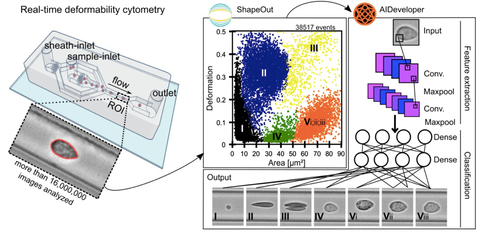Apr 08, 2022
Depressive disorders can lead to changes in immune cells
A recent study by the TU Dresden and the University of Zurich in cooperation with the Max Planck Institute for the Science of Light establishes for the first time a link between depressive disorders and mechanical characteristics of all major blood cell types. The results suggest that depressive disorders, and in particular persistent depressive disorders, are associated with a general increase in the deformability of immune cells, which could indicate deteriorated cell function and further explain the general exhaustion in many depression patients.
Loss of interest, joylessness, lack of drive and increased fatigability – all these complaints are among the main symptoms of depression, a mental illness affecting an estimated 5% of the population in Germany. Pathophysiological features of depressive disorders often include low-grade inflammation and elevated glucocorticoid output. In a new study published in the prestigious journal Translational Psychiatry, researchers from the Technische Universität Dresden, the University of Zurich, and the Max Planck Institutes for the Science of Light and the Max-Planck-Zentrum für Physik und Medizin Erlangen establish for the first time a link between depressive disorders and mechanical changes in blood cells. To do so, the researchers performed a cross-sectional case-control study using image-based morpho- rheological characterization of unmanipulated blood samples facilitating real-time deformability cytometry (RT-DC).
69 pre-screened individuals at high-risk for depressive disorders and 70 matched healthy controls were included and clinically evaluated by Composite International Diagnostic Interview, a globally recognized clinical interview for psychiatric disorders. Using the AI method of deep learning applied to over 16 million blood cell images, the main blood cell types were classified and morpho-rheological parameters such as cell size and cell deformability of each cell were quantified.
Thus, the scientists found that peripheral blood cells were more deformable in patients with depressive disorders compared to control subjects, while cell size was not affected. Individuals who had suffered from persistent depressive disorder over the course of their lives showed increased cell deformability in monocytes and neutrophils, while erythrocytes were more deformable in current persistent depressive disorder. Also lymphocytes were more deformable in individuals with a current depressive disorder.
Subsequently, the study shows for the first time that depressive disorders, and in particular persistent depressive disorders that persist over a period of more than two years, are associated with increased deformability of blood cells. While all major blood cells tend to show increased deformability, lymphocytes, monocytes and neutrophils are most affected. This suggests that mechanical changes in immune cells occur in depressive disorders, which could be causative for a sustained immune response. The identification of this pathomechanism could be accompanied by new possibilities for therapy in the future, which could restore dysfunctional cell function by improving cell mechanical processes.
For first author Dr. Andreas Walther, who conducted the study at the Chair of Biopsychology at TU Dresden but is now working at the Institute of Clinical Psychology and Psychotherapy at the University of Zurich, it means a lot to advance both biological as well as psychological therapies, that treat depressive disorders more efficiently and sustainably in the long term: "We are working in parallel on research into pharmacological therapies to improve a dysfunctional biology as well as psychological therapies to improve dysfunctional cognitive and emotional processes. Indeed, in my opinion, only a holistic approach can understand and efficiently treat this complex disorder and hopefully prevent much suffering in the future."
Original publication:
Andreas Walther; Anne Mackens-Kiani; Julian Eder; Maik Herbig; Christoph Herold; Clemens Kirschbaum; Jochen Guck; Lucas Daniel Wittwer; Katja Beesdo-Baum; Martin Kräter. Depressive disorders are associated with increased peripheral blood cell deformability: A cross-sectional case-control study (Mood-Morph). Translational Psychiatry. DOI: https://doi.org/10.1038/s41398-022-01911-3
Media inquiries:
Dr. Andreas Walther
Biopsychology
TU Dresden
and
Clinical Psychology and Psychotherapy
University of Zurich
Email:
Julian Eder
Biopsychology
TU Dresden

Real-time deformability cytometry and subsequent AI-based classification of blood cells.
Left: A schematic illustration of an RT-DC measurement chip is shown. Whole blood was resuspended in measurement buffer (CellCarrierB), drawn in a syringe, and connected to the sample inlet. CellCarrierB was used as a sheath fluid within a second syringe and the sample and sheath were flushed through the chip at a ratio of flow rates of 1:3 under constant flow (0.06 μL/s). The chip was mounted to an inverted microscope and an image of every cell was recorded at the end of a 600 μm long constriction cannel.
Right: Using ShapeOut, an open-source software tool, data were plotted. The dot-plot shows a measurement of 38,517 blood cells plotted in cell size (projected area [μm2]) and cell deformability. For better representation, the ratio of leukocytes (IV, Vi-iii) to erythrocytes and thrombocytes (I–III) is artificially increased. In order to identify the different blood cell types, the images were imported to AIDeveloper an open-source software tool to train, evaluate, and apply neural networks for image classification. A neural net based on the LeNet5 architecture, readily trained for the classification of blood cells, was loaded into AID and used to classify I = thrombocytes, II = erythrocytes, III = erythrocyte doublets, IV = lymphocytes, Vi = eosinophils, Vii = neutrophils, and Viii = monocytes. Finally, the mean values for cell deformability and cell size were extracted for every cell type individually.

